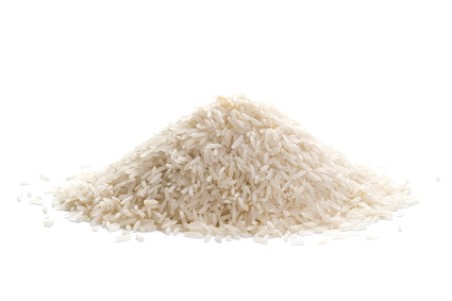By Nadia Marshall
What is Basmati Rice?
Basmati Rice is a variety of long grain rice grown in India, Pakistan and Bangladesh. It is known for its distinctive fragrance, delicate flavour and long, light grains. In fact basmati means ‘the fragrant one’ in Sanskrit. Basmati rice is held in very high esteem in Ayurveda because it is the lightest and most easy to digest of all the rices and has a peaceful effect on the mind/body. Basmati rice comes in lots of different varieties - it can be white, aged white, par-boiled white, red or brown. Grain lengths can also differ quite substantially between brands. When choosing your white basmati, it is best to buy long-grain aged basmati. Par-boiled rice is when they par-boil the rice before removing its husk which helps to drive the nutrients deeper into the grain. This rice is an off-white colour and is slightly translucent. It is a little heavier than white basmati but is a more nutritious choice. Red and Brown Basmati are also a little heavier as they contain more fibre....
What are its qualities?
From an Ayurvedic perspective, Basmati Rice has the following qualities...
Rasa: Sweet
Virya: Cooling
Vipaka: Sweet
Qualities: Light, Soft, Wholesome
Actions on the doshas: Tridoshic - balances Vata, Pitta and Kapha
Action on the mind: Sattvic
What are its medicinal qualities?
Like moong daal, Basmati rice is sweet/cooling/sweet and light. This is a rare combination. Usually foods that are sweet/cooling/sweet are also heavy. So, like moong daal, basmati rice has the special quality of being nourishing for the tissues and immune system (due to its sweetness) but also light and easy to digest. Basmati’s purely Sweet taste and post-digestive effect has a calming, grounding effect on the mind/body. It is also considered a Sattvic grain which means it helps to directly cultivate peace, clarity and contentment in the mind. In Ayurveda, basmati is considered the queen of grains!
The Western viewpoint.
From a western perspective, basmati is also one of the best choices when it comes to rice. It has a neutral pH and a medium GI which makes it a better choice for people with diabetes. Red basmati rice is even better from a GI perspective with a GI of just 48. Basmati rice contains mostly carbohydrates, some protein but also a little fat, vitamins and minerals. It is a good source of the B vitamins, thiamine and niacin, as well as iron. And.... if consumed with moong daal or another legume/pulse, you have yourself a complete protein with all your essential amino acids!
How do you eat it?
We have basmati with everything! We have it in our kicharees, pilaus and as a side grain to all of our veggie or daals and curries. And when we have some left over, we cook it with milk, sugar and spices to make a delicious porridge in the morning or pudding in the evening. If we’re cooking a risotto or sushi we use risotto or sushi rice… but for pretty much everything else, we use basmati. Although we mostly choose aged white basmati, we often have red instead… and sometimes a combination of the two because they cook at the same rate so can easily be combined.... and look so pretty together!
Here's a hot tip - If cooking a lot of rice for a large number of people, red-rice or par-boiled rice can be an easier choice because it holds its shape better under the pressure of a large quantity of rice. White basmati can get a little squished and not turn out to be as light and fluffy as it is when cooking smaller amounts.
Why do I love it?
I eat basmati rice every day. I just absolutely love how good it tastes and how great it feels in my belly. I grew up eating stodgy boiled rice so was never really into it. I always preferred potatoes. As you would. But when I learned how to cook rice properly and could make it better than most restaurant rice, I was 100% converted. If you want to know how to make awesome rice, read my blog on the subject x
Should anyone avoid eating it?
No. Anyone and everyone can and should eat basmati rice. You would only avoid it if you were put on a very specific Ama-reducing fast by your Ayurvedic Practitioner and were instructed to avoid all grains (but this would usually only be for 3-10 days at a time). If you have diabetes you may be advised to eat more of the red variety, along with other low GI grains.
Where do you get it from?
The good news is you can get reasonably good quality white basmati rice from Woolies. The ‘Taj’ brand is best and even the basmati in the white bags is okay (but not great). But... avoid all other basmati on the shevles as it is pretty average. If you can, it is best to go to an Indian grocer and buy India Gate. It is so easy to cook and tastes about a million times better than your average supermarket basmati. You’ll also only find Red Basmati or Par-boiled White Basmati at an Indian Grocer. Or... if you'd like to get certified organic Basmati Rice, you should be able to source it from your local wholefood store. In Byron, you can get it from Santos Wholesale (these guys also sell their stuff online).
I hope this gets you excited about Basmati. Tell me about your experience with it... and why you love it!
Finally, to the right is a video showing one way to cook basmati rice... as a Rice Pilau. It makes a fantastic lunch or light dinner... or you can have it with a daal, curry or soup.
Love
Nadia x

Basmati Rice: The Ayurvedic Perspective
AYURVEDIC TERMINOLOGY
Agni - the digestive fire.
Ama or Aama - undigested food waste, toxins.
Ojas- the foundation of our immune system and longevity.
Dhatus - the tissues of the body.
Srotas - the channels of the body.
Vata - the air/ether
intelligence in the body.
Pitta- the fire/water
intelligence in the body.
Kapha- the water/earth intelligence in the body.
Sattva- the quality of purity, intelligence, peace and love.
Rajas- the quality of
turbulence and activity.
Tamas- the quality of
dullness, darkness and inertia.
Rasa - the taste of a food (Sweet, Sour, Salty, Pungent, Bitter, Astringent)
Virya - second level of digestion (either Heating or Cooling)
Vipaka - third level of digestion, the deep taste of a food (can be Sweet, Sour or Pungent)
Prabhav - the 'special effect' of a food or herb/spice
Rasa - also the name for plasma tissue
Rakta - blood tissue
Mamsa - muscle tissue
Meda - fat tissue
Asthi - bone tissue
Majja - nerve & bone marrow tissue
Shukra - sexual reproductive tissue


